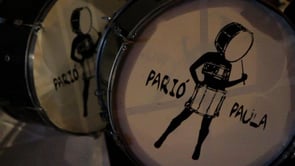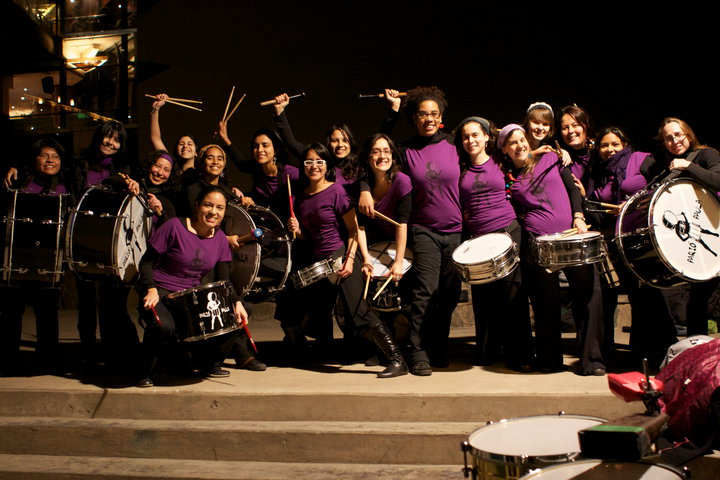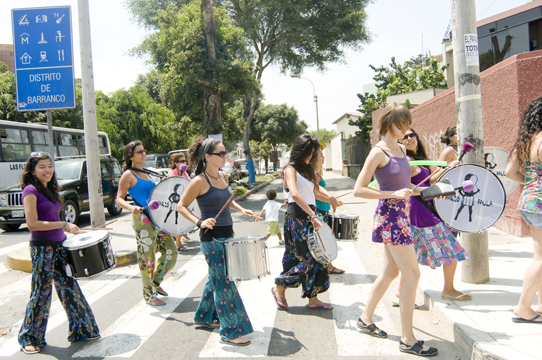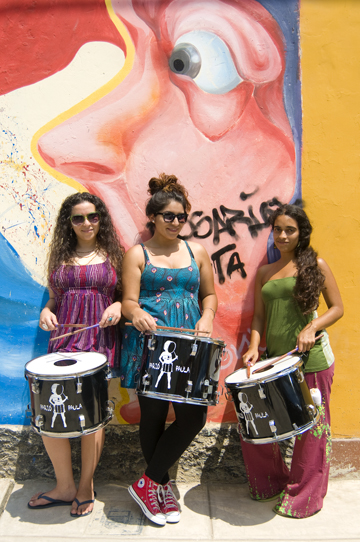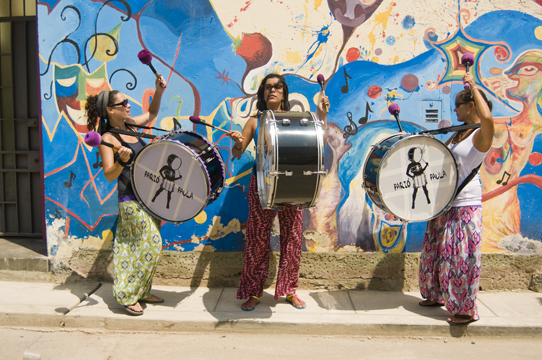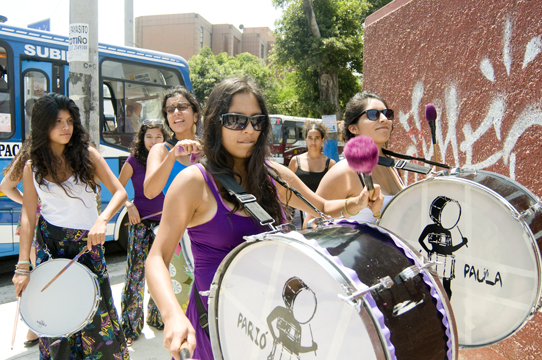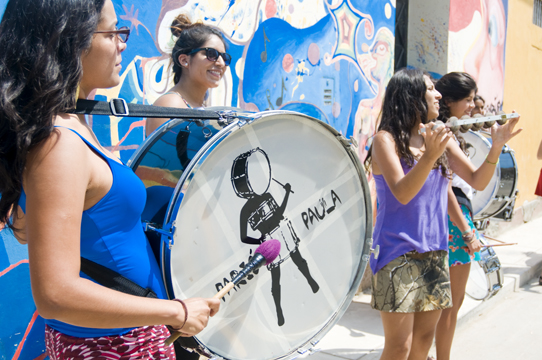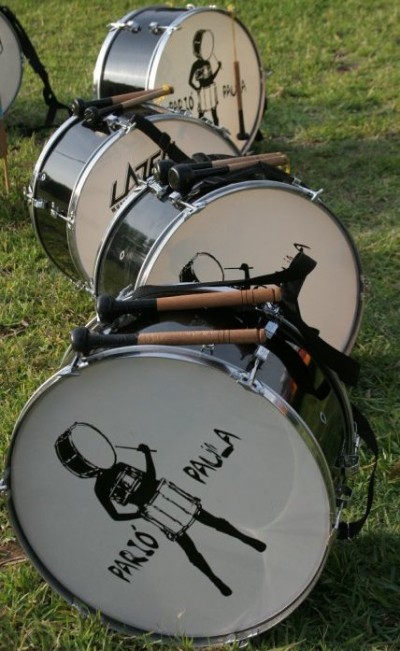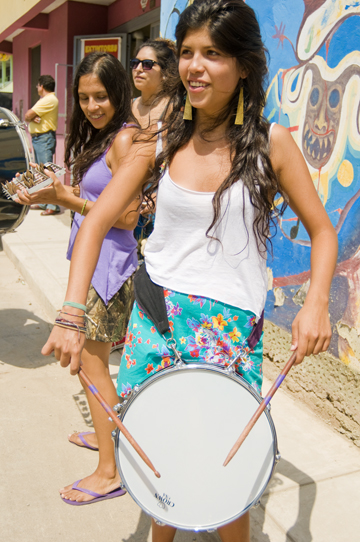Parió Paula is an all women’s percussion group based in Lima, Peru. These women are truly artistic renegades defying the social norms of Lima’s predominantly male artist scene. With a bold message on emphasizing female expression, these ladies have transformed their countless styles of drumming into something effective for their city.
I first started playing with Parió Paula in early 2010, when I moved to Peru to do an anthropological study of women musicians in the male-dominated music scene of Lima, the country’s capital city. Laura Robles, a prominent cajón player, drummer and bass player in Lima, formed Parió Paula in 2009 when she grew tired of often being the only woman in her wide array of bands, ensembles and musical projects. “One day I said never again, I’d rather do anything but this, and that’s when I decided to create an all women’s ensemble.”
Laura told a handful of friends about her idea to create an all women’s percussion group, and they started out rehearsing on buckets in Laura’s house. At first Laura was the only one to compose grooves, pulling from a rich array of influences, including Afro-Peruvian festejo, merengue, salsa, samba reggae, and even pop and funk. By late 2009 they found an independent rehearsal space, which has since become a hub of vibrant cultural activity and is nicknamed “la casita Paula,” and Laura financed out of pocket their first set of real instruments. She bought “bombos” (kick drums), “tarolas” (snares), and “napoleons” (toms), and this 3-drum arrangement is what they play to this day, though they have since acquired new instruments and added some auxiliary percussion.
In early 2011, Laura moved to Germany to pursue her independent music career as a cajón player and composer. Rather than disbanding, the Paulas took on the challenge of becoming a leaderless percussion ensemble and developed a method of collective composition and direction. “Usually one of us comes in with a basic rhythmic pattern to develop with the group, and then we play on top of that and come up with new ideas.” Right now there are two central Paulas who take turns leading the group during rehearsals, “but there are others who are training to take on this role.”
Through this collective method they are currently working out a new composition based on a groove from Senegal, a Landó (from Afro-Peruvian folk music) and a Saya-Morenada (both rhythms from Andean folk music).
La casita Paula is hard to miss if you are walking down the back streets of Barranco, Lima’s most bohemian and artistic borough. The wall facing the street is a canvas for an ever-changing colorful mural, and the rumble of drums can be heard from blocks away. Inside the house the walls are covered with paintings, photographs, and political stickers. On the back patio there are usually Paulas conversing about music, politics and upcoming projects.
Parió Paula’s sense of social responsibility and political awareness comes across in the kinds of performances and projects they take on in the larger community. Their last performance was part of the Cantagallo Fest, a fundraising event for a community of Shipiba people, originally from the central Amazon, which is living in extreme poverty in the outskirts of Lima. They are also collaborating with the French Alliance of Lima in a project promoting the artistic expression of women in Lima called Palabra de Mujer. They give classes at schools in Lima, and are trying to travel more throughout Peru for performances and workshops.
Right now the central performance group of Parió Paula is 22 women-strong, though there are about 45 more women in training. For the Paulas, it is absolutely essential that the group be a space for women only. “It’s not a very common space to find in our culture, where 95% of artists are men, and the women that do navigate in this artistic scene confront dynamics and a logics are predominantly masculine. So Parió Paula is an experiment, where we come together to create, learn, have fun and rediscover the nature of collective feminine creativity.”
After playing with Parió Paula for six months, I had the tremendous opportunity to produce a short documentary about the group, with directors Patricia Alvarez Astacio and Christopher Newman. The short film, entitled “Por Fin Parió Paula,” was released in early 2012 and has been making the rounds of various programs and festivals in the US. It depicts the moment in Parió Paula’s history in which it was still under the leadership of Laura Robles.
And who is Paula, after all? Before leaving for Germany, Laura told me the legend of Paula: “They told me a story that Paula was a young woman who had a terrible time delivering her child. Absolutely terrible! It lasted days and days and days. Until one day she finally gave birth, and her farther said: “Parió Paula!” (Paula had her baby!) So that phrase came about. When something is taking you forever, it demands a ton of energy and time, and then finally you finish it, you use this phrase: “Por fin Parió Paula!” (Paula finally had her baby!)”
By Adele Fournet
Photos by Robin Hann
* Correction: Pario Paula photos printed in Tom Tom’s print Issue 11 by RevNep Manifiesto


